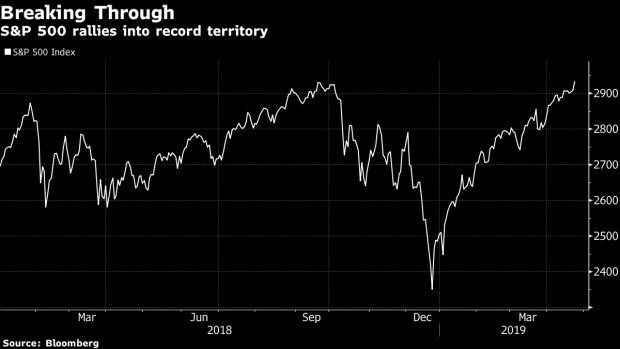Apr 24, 2019
S&P 500 Record Has Skeptics But Some Strategists See Upside
, Bloomberg News

(Bloomberg) -- The S&P 500’s vulnerabilities are myriad. Stocks may be overvalued, the economy might be weakening, trade tensions are everywhere -- the list goes on. And yet, here we are at a record high, contemplating where the gauge goes from here.
“The market recovery from the downturn at the end of last year is now complete,” declared Brad McMillan, the chief investment officer for Commonwealth Financial Network. “With markets breaking out again, the likelihood of further gains is high, especially if earnings continue to come in ahead of expectations.”
The S&P 500 rose 0.9 percent to close at a record 2,933.68 on Tuesday after the likes of Twitter Inc. and Lockheed Martin Corp. rallied on positive earnings surprises. Futures were little changed on Wednesday at 7:30 a.m. in New York. So far this reporting season, 79 percent of companies have beaten profit estimates. That has propelled the gauge almost to the 2,950 median year-end level seen by strategists tracked by Bloomberg, meaning it has already eclipsed the expectations of many market watchers.
“FOMO,” or fear of missing out, has been the subject of discussion for weeks given the torrid pace of the equity rally that started 2019. And so far investors haven’t quite responded by jumping in en masse, but expectations continue that they will join at some point.
“Given the level of potential underinvestment by hedge fund longs, we see the possibility of a ‘catch-up’ trade in U.S. equities,” Macro Risk Advisors’ New York-based quantitative strategist Max Grinacoff wrote in an April 23 note. “Look at the rolling one-month beta of daily returns for the HFRI Global Hedge Fund Index against the S&P 500 as a proxy for level of investment -- this measure is nearly 2.5 standard deviations below the five-year mean.”
And then there are the technicals.
Citigroup Global Markets senior technical strategist Shyam Devani says the next meaningful level above 2,940, the intraday record, is the trend across the January 2018 and September 2018 highs. That comes in at 3,001.
Beyond that, “we expect gains of approximately 25 percent for the year (giving a target of around 3,132),” Singapore-based Devani said April 24.
Watching 3,000
Evercore ISI technical strategist Rich Ross’s view dovetails with Devani’s -- the S&P 500 “remains in position to trade 3,000 on the breakout” and there’s “still room here” for advancement, he said in an April 23 note.
The historical record argues that stocks could continue upward, as well.
“This marks one of the best-ever recoveries from at least a correction from an all-time high,” according to Jason Goepfert, the founder of Sundial Capital Research. He examined the S&P 500’s performance after full recoveries from losses in patterns like the current period, and found it was “pretty good,” if not “great.”
“Returns were about in line with random, and the risk/reward was about what we usually see,” Goepfert said. “The most impressive time frame was over the next year, which was consistently positive enough to suggest significance.”
While it’s been a feature of post-Financial Crisis markets to have a strong element of skepticism, even strategists who are cautious for the immediate time frame may see advances further down the road.
Chris Zaccarelli, the North Carolina-based chief investment officer of Independent Advisor Alliance LLC, has near-term concerns. He cites a low VIX showing complacency and some technical indicators crossing into overbought levels, but says that “over the long term, this bull market should be able to sustain any pullbacks and could run for another 1-2 years.”
Even cyclical concerns are somewhat on hold for the time being, especially after the Federal Reserve pivoted to a more dovish stance, easing concerns that tighter conditions might send the economy into recession.
“While now late cycle, we view the current growth, inflation, and monetary policy environment as still supportive of risk assets,” Brian Rose of UBS’s wealth-management arm wrote in a note April 22. “In our tactical asset allocation we remain risk-on.”
“Many of the concerns that took markets down in the fourth quarter have faded,” Commonwealth’s McMillan wrote:
- The Mueller report was less damaging than feared
- Brexit has turned from tragedy to farce
- And for all the worries about growth and corporate earnings, both seem to be beating expectations
“With the passing of much of the worry, markets may be now free to keep moving higher,” McMillan said.
(Adds futures in third paragraph.)
--With assistance from Rita Nazareth.
To contact the reporter on this story: Joanna Ossinger in Singapore at jossinger@bloomberg.net
To contact the editors responsible for this story: Christopher Anstey at canstey@bloomberg.net, Divya Balji, Teo Chian Wei
©2019 Bloomberg L.P.


